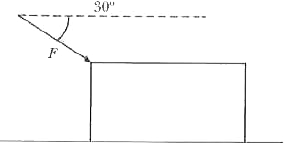A 12 N horizontal force →F pushes a block weighing 5.0 N against a vertical wall (Fig. 6-41). The coefficient of static friction between the wall and the block is 0.00, and the . coefficient of kinetic friction is 0.40. Assume that the block is not moving initially. (a) Will the block move? (b) In unit-vector notation, what is the force on the block from the wall?

The block does not slide, (b) →Fw=−FNˆi+fˆi=−(12N)ˆi+(5.0N)ˆj
Topper's Solved these Questions
- FORCE AND MOTION-IIBOOK - RESNICK AND HALLIDAYCHAPTER - FORCE AND MOTION-IIEXERCISE - PRACTICE QUESTIONS (Single Correct Choice Type)
23 Videos
- FORCE AND MOTION-IIBOOK - RESNICK AND HALLIDAYCHAPTER - FORCE AND MOTION-IIEXERCISE - PRACTICE QUESTIONS (More than One Correct Choice Type)
4 Videos
- FORCE AND MOTION-IIBOOK - RESNICK AND HALLIDAYCHAPTER - FORCE AND MOTION-IIEXERCISE - CHECKPOINTS
5 Videos
- FORCE AND MOTION - I BOOK - RESNICK AND HALLIDAYCHAPTER - FORCE AND MOTION - I EXERCISE - PRACTICE QUESTIONS (Integer Type)
3 Videos
- GAUSS' LAW BOOK - RESNICK AND HALLIDAYCHAPTER - GAUSS' LAW EXERCISE - PRACTICE QUESTIONS (INTEGER TYPE)
3 Videos
Similar Questions
A block of weight 5N is pushed against a vertical wall by a force 12 N. The coefficient of friction between the wall and block is 0.6. The magnitude of the force exerted by the wall on the block is

View SolutionA horizontal force of 10 N is necessary to just hold a block stationary against a wall. The coefficient of friction between the block and wall is 0.2. What is the weight of the block?

View Solution
Knowledge Check
A block of weight 5 N is pushed against a vertical wall by a force 12 N . The coefficient of friction between the wall and block is 0.6 . Find the magnitude of the force exerted by the wall on the block :
 A12 NB13 NC17 ND16 N
A12 NB13 NC17 ND16 NA horizontal force of 10N is necessary to just hold a block stationary against as well. The coefficient of friction between the block and the wall is 0.2. The weight of the block is
 A20 NB50 NC100 ND2 N
A20 NB50 NC100 ND2 NA horizontal force of 10N is necessary to just hold a block stationary against as well. The coefficient of friction between the block and the wall is 0.2. The weight of the block is
 A(a) 20NB(b) 50NC(c) 100ND(d) 2N
A(a) 20NB(b) 50NC(c) 100ND(d) 2N
A horizontal force of 10N is necessary to just hold a block stationary against a wall.
The coefficient of fricition between the block and the wall is 0.2 then find the weight of the block. (g=10m/s2)

View SolutionA force of F = 12.0 N is applied to a 8.00 kg block at a downward angle of 30∘ as shown in the figure.

The coefficient of static friction between the block and the floor is 0.700 and the coefficient of kinetic friction is 0.400. What is the magnitude of the frictional force on the block?
View SolutionA block pressed against the vertical wall is in equilibrium. The minimum coefficient of friction is:

View SolutionA block pressed against the vertical wall is in equilibrium. The minimum coefficient of friction is:

View SolutionA horizontal force of 10 N is necessary to just hold a block stationary against a wall. The coefficient of friction between the block and the wall is 0.2. the weight of the block is (g=10m/s2)

View Solution
